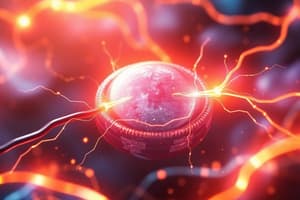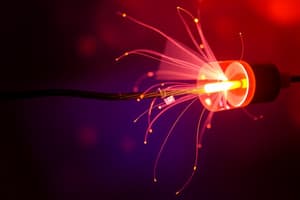Podcast
Questions and Answers
Which component is specifically described as allowing current to flow in both forward and reverse directions?
Which component is specifically described as allowing current to flow in both forward and reverse directions?
- Diode
- Zener diode (correct)
- Fuse
- Resistor
What function does a resistor serve in an electronic circuit?
What function does a resistor serve in an electronic circuit?
- It allows current to flow in one direction only.
- It limits the flow of electrical current. (correct)
- It converts light into electrical current.
- It provides supply to the circuit.
What is the primary purpose of a fuse in an electrical circuit?
What is the primary purpose of a fuse in an electrical circuit?
- To convert electrical energy into light.
- To limit the flow of current.
- To provide a supply to the circuit.
- To break the circuit if too much current flows. (correct)
Which of the following devices is responsible for converting light into electrical current?
Which of the following devices is responsible for converting light into electrical current?
What does a schematic diagram primarily represent in electrical engineering?
What does a schematic diagram primarily represent in electrical engineering?
What is the definition of conductivity?
What is the definition of conductivity?
Which of the following materials is considered a good conductor?
Which of the following materials is considered a good conductor?
What distinguishes insulators from conductors?
What distinguishes insulators from conductors?
What is resistivity?
What is resistivity?
Which of the following materials is NOT a good insulator?
Which of the following materials is NOT a good insulator?
Which tool is specifically designed for removing wire insulators without damaging the wire conductor?
Which tool is specifically designed for removing wire insulators without damaging the wire conductor?
What is NOT an example of an insulator?
What is NOT an example of an insulator?
What function does a DC bench power supply serve?
What function does a DC bench power supply serve?
What significant invention is Pieter van Musschenbroek known for?
What significant invention is Pieter van Musschenbroek known for?
Who discovered X-rays and referred to them as 'X-ray' for their unknown nature?
Who discovered X-rays and referred to them as 'X-ray' for their unknown nature?
Which scientist is recognized for developing Coulomb's law?
Which scientist is recognized for developing Coulomb's law?
What did Nikola Tesla invent that is critical for high voltage generation?
What did Nikola Tesla invent that is critical for high voltage generation?
What concept did Benjamin Franklin define related to electricity?
What concept did Benjamin Franklin define related to electricity?
Which inventor is associated with the AC generation and transmission technology?
Which inventor is associated with the AC generation and transmission technology?
What was a major outcome of the War of the Currents?
What was a major outcome of the War of the Currents?
Which scientist is credited with the invention of the battery?
Which scientist is credited with the invention of the battery?
What is the primary function of a solenoid in electrical engineering?
What is the primary function of a solenoid in electrical engineering?
Which of the following individuals is known as the 'Father of wireless'?
Which of the following individuals is known as the 'Father of wireless'?
What important law did George Simon Ohm discover?
What important law did George Simon Ohm discover?
What is a diode used for in electrical circuits?
What is a diode used for in electrical circuits?
Which individual built the first electric motor?
Which individual built the first electric motor?
What is the significance of the unit of capacitance being named after Michael Faraday?
What is the significance of the unit of capacitance being named after Michael Faraday?
In the context of semiconductors, which of the following inventors is associated with developing a more practical approach to integrated circuits?
In the context of semiconductors, which of the following inventors is associated with developing a more practical approach to integrated circuits?
Which concept does Gustav Robert Kirchhoff's work in electrical circuits mainly relate to?
Which concept does Gustav Robert Kirchhoff's work in electrical circuits mainly relate to?
What is the primary purpose of a wiring diagram?
What is the primary purpose of a wiring diagram?
Which of the following best describes conductors?
Which of the following best describes conductors?
How can wiring diagrams assist electricians during repairs?
How can wiring diagrams assist electricians during repairs?
What is a notable feature of wiring diagrams?
What is a notable feature of wiring diagrams?
In fault finding, what advantage do wiring diagrams offer?
In fault finding, what advantage do wiring diagrams offer?
Which term is used to describe the flow of electrons?
Which term is used to describe the flow of electrons?
What does the main wire in a wiring diagram connect to?
What does the main wire in a wiring diagram connect to?
What is the role of visual representation in wiring diagrams?
What is the role of visual representation in wiring diagrams?
Flashcards are hidden until you start studying
Study Notes
Conductivity and Types of Materials
- Conductivity refers to the transfer of charge, electricity, or heat through substances.
- Conductors allow electricity and heat to flow easily; examples include gold, aluminum, brass, silver, steel, copper, and even water.
- Insulators restrict the flow of electricity and heat; common insulators include glass, quartz, wood, wool, plastic, and rubber.
- Resistivity is a measure of a material’s resistance to current flow, a vital property for comparing materials.
Key Tools and Equipment
- Soldering Station: Used for assembling or reconnecting electronic components.
- Oscilloscope: Displays electrical signals and oscillations in real-time, vital for analysis in electronics.
- DC Bench Power Supply: Acts to limit current and voltage in electronic setups.
- Wire Stripper: Removes insulation from wires without damaging the conductor.
Historical Figures in Electricity
- Pieter van Musschenbroek: Inventor of the Leyden jar, an early capacitor.
- Benjamin Franklin: Researched static electricity; invented the electrostatic generator.
- Luigi Galvani: Studied the effects of electricity on frogs.
- Alessandro Volta: Invented the battery; unit of voltage is named after him.
- André Marie Ampère: Studied the relationship between electricity and magnetism; unit of current named in his honor.
- Nikola Tesla: Developed AC motors and transmission technology; famous for the Tesla coil.
- Thomas Edison: Patented the phonograph and DC system; famously involved in the "War of Currents."
- James Clerk Maxwell: Created foundational equations in electricity and magnetism.
Electrical Concepts
- AC (Alternating Current): Electric current that periodically reverses direction.
- DC (Direct Current): Current flows in one direction only.
- Resistors: Components that limit electrical current in circuits.
- Diodes: Allow current to flow in a single direction.
- Zener Diodes: Permit current flow in both directions under certain conditions.
- Photodiodes: Convert light into electrical current.
Electrical Diagrams
- Schematic Diagram: Uses standardized symbols to represent components in a circuit.
- Wiring Diagram: Depicts the physical connections and layout of the electrical system.
- Fuses: Protect circuits by breaking the flow of current when it becomes excessive.
- Switches: Control the flow of electricity within a circuit.
Key Principles
- Electricity: Defined as the flow of electrons in a conductor.
- Conductors allow charge transfer across surfaces; essential for electrical applications.
- Wiring diagrams aid in troubleshooting and illustrate the interconnections in a circuit.
Applications
- Understanding and applying these principles is crucial for modern electronics design, repair, and innovation.
- Knowledge of historical figures highlights the evolution of electrical engineering and its foundational discoveries.
Studying That Suits You
Use AI to generate personalized quizzes and flashcards to suit your learning preferences.




